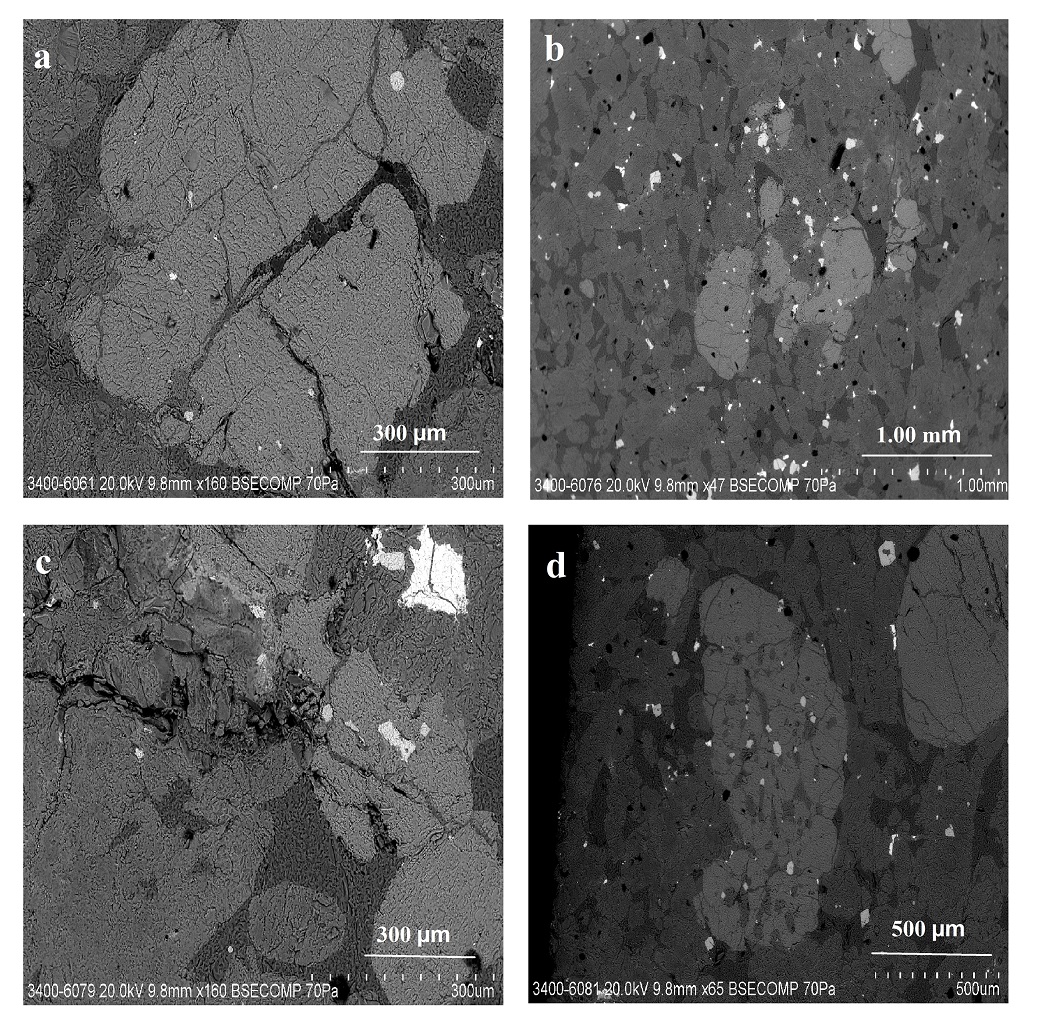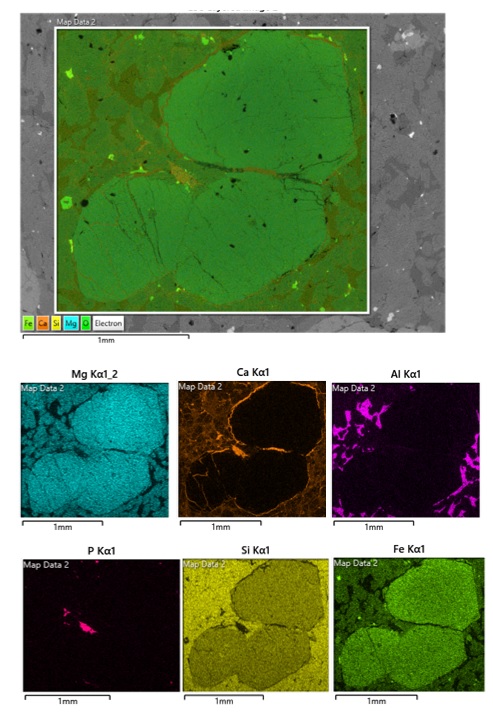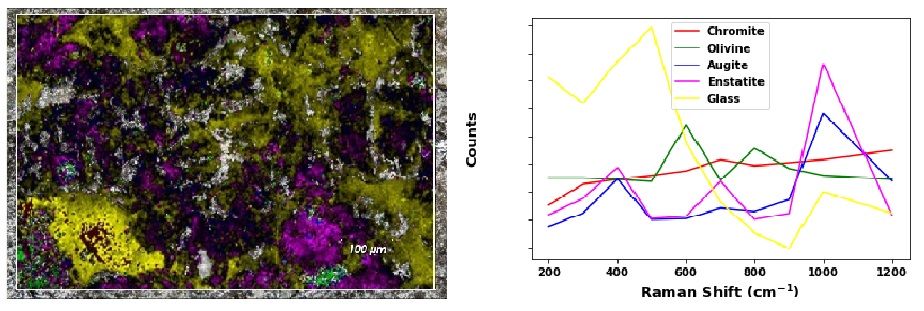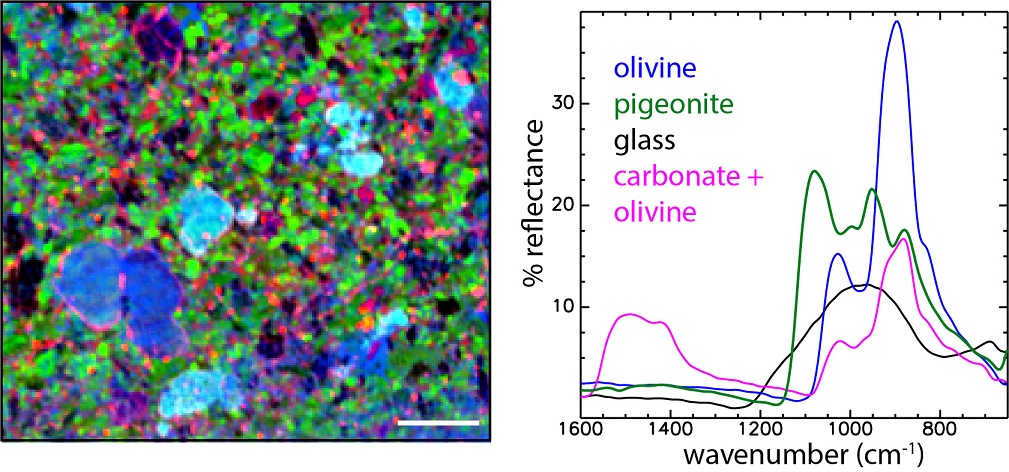Mineralogy of shergotite Dar al Gani 476 as an analogue of Martian surface
- University of Hong Kong, Department of Earth Science, Hong Kong
Introduction: Successful exploration of Mars could benefit from a detailed knowledge of mineralogy of Martian surface materials [1]. One of the most explicit studies of minerals on Mars, would be done on Martian meteorites. Dar al Gani 476 is one of the most mafic basaltic shergottites found so far [2] which was found in the Saharan desert in Libya in 1998 from the Dar al Gani region. The volume of the sample is 4.15 × 8.58 mm, the thickness is 0.88 mm and it weights 0.1511 gr. It is an igneous rock rich in olivine and pyroxene, with some shock metamorphosed minerals and glass. In this work, to achieve high accuracy on the mineral identification of the igneous rock, we applied a combination of FTIR microspectroscopy and Raman spectroscopy.
Methods: The Raman spectra were obtained from an inVia Renishaw Raman imaging spectrometer with a high spectral (1cm-1) and spatial resolution. The excitation wavelengths of 532 nm laser line was used for this study. Scanning of a big area of the sample covers the areas of 837 × 534 µm, using 50× long working distance objective, 5s exposure time and 10% of the laser power (4.59mW). MicroFTIR mapping was done by the Thermo Scientific nicolet Infrared Microscope. Back-scattered electron images (BSE) were taken with Hitachi S-3400N Scanning electron microscopy with energy dispersive spectrometers (EDS) (EMU, Hong Kong University).
Results and Discussion: The BSE image of DaG 476 illustrates its porphyritic texture (Figure 1). As a most mafic basaltic shergottite, it contains olivine and pyroxene with a high Mg content. EDX elemental maps reveal the presence of Si, Al, Ca, Mg, Fe, and P and other elements, including Na, S, Cr and C [3] (Figure 2).

Figure 1. BSE image of DaG 476. (a) large light-gray grains are olivine, (b) white dots are representatives of silicon, (c) white phases are Fe-oxides and sulfide, (d) large pyroxene grains with dark cores, black areas are feldspathic glass.
Raman mapping and distribution of minerals has been shown in Figure 3. The presence of anhydrous silicates such as olivine and augite has been observed. Augite and enstatite show Raman peaks at 231, 323, 388,664, 675, 1006 and 1013 cm−1 (Table 1). The range and distribution of pyroxene compositions indicate that the rock did not cool and crystallize slowly [4]. This broad range of pyroxene composition is consistent with chemical zoning preserved during rapid crystallization and supports a basaltic texture.The presence of the volcanic glass, suggest that rock had been shocked and cooled rapidly with mineral crystal growth. Feldspar melting glass consists mainly of glass (> 97%) and rich in the lighter elements such as Si, O, Al, Na and as an evidence of past volcanic activity, its plagioclase feldspar was converted to a volcanic glass [5].

Figure 2. EDX elemental map from of the DaG 476 sample.
Table 1. Specific Raman peaks of DaG 476 Martian meteorite sample and the minerals designation.
|
Mineral |
Raman peaks/cm-1 |
|
Raman Catalogue (https://rruff.info) | |||||||
|
Olivine |
816 |
848 |
822 |
851 |
||||||
|
Augite |
323 |
388 |
664 |
1013 |
328 |
395 |
665 |
1011 |
||
|
Chromite |
281 |
322 |
670 |
677 |
1004 |
1086 |
337 |
680 |
684 |
1006 |
|
Glass |
483 |
961 |
989 |
1007 |
484 |
960 |
998 |
|||
|
Enstataite |
231 |
655 |
675 |
1006 |
238 |
344 |
664 |
686 |
1012 |
Glassy materials have weaker Raman scattering than crystalline minerals. Although glassy materials often dominate the spectrum, the Raman peaks of glass can be easily masked by the peaks of the crystalline phases when they are sampled together. The rock might be sufficiently shocked and its plagioclase might have bene destroyed (Figure 3).

Figure 3. Compositional map of the DaG 476 and Raman spectra of minerals
Figure 4 shows the presence of carbonates in the sample which probably formed on earth once the meteorite landed. It’s confirmed as terresterian carbonate due to having a noticeable effect on the bulk oxygen isotopic composition [6]. It is concluded in previous research that carbonate component of DaG 476 is associated with impact-melt pockets [6]. In the porphyritic texture of the meteorite, a fine grained ground mass of clinopyroxene is surround by olivine. The pyroxene consists primarily of pigeonite and augite, although enstatite has been observed by Raman spectrsocopy [7].

Figure 4. Distribution of minerals in the FTIR image of Dag 476 and IR spectra of minerals.
Conclusions: This work confirms the potential value of Raman spectroscopy and FTIR microspectroscopy for mineral analysis of different types of meteorites and returned samples. Peak positions and spectral patterns have lead us to identify the minerals and their distribution in DaG 476 sample. DaG 476 has a fine-grained groundmass consisting of pyroxene and the fine-grained amorphous silicate material found in veins and pockets, isolated olivine and single chromite grains occur in the groundmass. The spectra of the volcanic glass has been detected in the rock which may have been formed when lava of a volcano cooled rapidly, i.e. the DaG 476 may be separated from a part of the surface where lava was flooded in ancient times. Combination of Raman spectroscopy and FTIR microspectroscopy provide a capability to estimate the carbonate minerals and silicates in meteorites and planetary analogue samples.
References: [1] Wang, A., et al. (2003) Journal of Geophysical Research: Planets, 108(E1). [2] Zipfel, J., et al. (2000). Meteoritics & Planetary Science, 35(1), 95-106. [3] Wadhwa, M., et al. (2001). Meteoritics & Planetary Science, 36(2), 195-208. [4] Borg, L. E. et al. (2003). Geochimica et Cosmochimica Acta, 67(18), 3519-3536. [5] Crozaz, G., & Wadhwa, M. (2001). Geochimica et Cosmochimica Acta, 65(6), 971-977. [6] Wright, I. P., et al. (1999). In Lunar and Planetary Science Conference (p. 1594). [7] Borg, L. E., et al. (2003). Geochimica et Cosmochimica Acta, 67(18), 3519-3536.
How to cite: Tanbakouei, S., Michalski, J. R., and Wright, S. P.: Mineralogy of shergotite Dar al Gani 476 as an analogue of Martian surface, Europlanet Science Congress 2022, Granada, Spain, 18–23 Sep 2022, EPSC2022-947, https://doi.org/10.5194/epsc2022-947, 2022.

